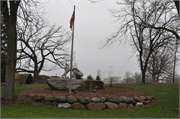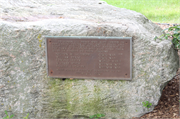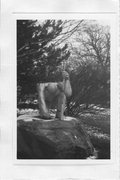| Additional Information: | A 'site file' exists for this property. It contains additional information such as correspondence, newspaper clippings, or historical information. It is a public record and may be viewed in person at the State Historical Society, Division of Historic Preservation.
S in the photo codes is short for SOS! See SOS! files at the National Museum of American Art in Washington, D.C. for more information.
2012: This war memorial was designed in 1970 by Wisconsin sculptor Harry Whitehorse and erected at the site c1974. The memorial consists of an aluminum sculpture of a soldier on a rough base made of Minnesota granite. A bronze plaque on the base reads "TO HONOR ALL THOSE WHO HAVE SERVED IN THE ARMED FORCES OF THE UNITED STATES AND ESPECIALLY DEDICATED TO THOSE RESIDENTS OF THE TOWN OF FITCHBURG WHO HAVE GIVEN THEIR LIVES IN SERVICE TO THEIR COUNTRY." A list of veteran of the Civil war, World War I, and the Vietnam War follows. the monument was commissioned by Niles and Hazel Schley in honor of their son Robert who was killed in action during the Vietnam War in 1967.
2019 City of Fitchburg survey recommendation write-up:
Resting upon a Minnesota granite base, this aluminum sculpture consists of a male figure in uniform, kneeling on one knee in a state of weariness, with a rifle in his hand.
The sculpture, entitled “Weary Veteran,” was designed and created by sculptor Harry Whitehorse, a Winnebago Indian. The sculpture was commissioned by the Fitchburg Club as a memorial for a local boy (Bob Schley) lost to the Vietnam War, as well as other Fitchburg casualties of war. The piece of land upon which the sculpture was installed was donated to the Town of Fitchburg by Mr. and Mrs. Tom Gorman, on behalf of the Fitchburg Club. At that time, the Fitchburg Town Hall was located adjacent to the donated parcel, now known as Gorman Wayside Park. The club, which was organized in 1968 to develop, promote, and support the various activities of the town, was open to all Fitchburg residents. The sculpture was completed and installed in 1973 (or 1974).
Monona sculptor and painter Harry Whitehorse was born in 1927 near the Indian Mission in Black River Falls, Wisconsin. He served in the Navy in World War II, during which time he visited museums while on leave. Upon his return, he attended the University of Madison, where he studied both human and animal anatomy. He also attended the Arthur Colt School of Fine Arts in Madison, where he studied oil painting. In addition, he apprenticed to his uncle who worked as a silversmith. He also learned how to work metal in a factory and, later, as owner and operator of Chief Auto Body & Repair in Madison. As of 1966--the year he was awarded first prize for his submission to the Capital Times-Madison Art Association Sidewalk Art Fair-- his design influence was identified as Michelangelo. Following that award-winning sculpture, Whitehorse received a number of commissions. Among his known works include a baptismal font at St. Matthew’s Lutheran Church (30 Dempsey Road, Madison; 1971); “Let the Great Spirit Soar,” (1991); and “Asclepius,” (1964), the latter two of which (along with the Fitchburg sculpture) are recorded by the Smithsonian. In August of 2019, Whitehorse’s “The Badger,” a 10-foot-long bronze statue made from the model he created approximately a decade earlier, will be installed across the street from Camp Randall Stadium and dedicated in September.
|
|---|
| Bibliographic References: | “Architecture/History Survey: Local Road Intersection Improvements In Madison & Fitchburg.” WHS project number 12-0937/DA. March 2012. Gail Klein.
For footnotes to 2019 survey write-up below, See the Historical & Architectural Resources Survey, City of Fitchburg, Dane County, Wisconsin, by Traci E. Schnell/tes | Historical Consulting, LLC, completed in 2019. |
|---|




